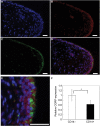Increase and regulation of synovial calcitonin gene-related peptide expression in patients with painful knee osteoarthritis
- PMID: 28546767
- PMCID: PMC5436753
- DOI: 10.2147/JPR.S135939
Increase and regulation of synovial calcitonin gene-related peptide expression in patients with painful knee osteoarthritis
Abstract
Background: Recent studies suggest that the vasodilatory neuropeptide calcitonin gene-related peptide (CGRP) is localized in the synovial tissue and may be involved in the pathology of hip and knee osteoarthritis (OA). However, the regulation and relationship between pain and CGRP expression levels in the synovial tissue of human OA patients are not fully understood.
Methods: Synovial tissues were harvested from 74 participants with radiographic knee OA (unilateral Kellgren/Lawrence grades 3-4) during total knee arthroplasty. CGRP-expressing cells in the resected tissue were identified by immunohistochemical analyses. To examine CGRP expression levels, CD14-positive (CD14+) (macrophage-rich cell fraction) and CD14-negative (CD14-; fibroblast-rich cell fraction) cells were isolated from the synovial tissue. To investigate the involvement of prostaglandin E2 (PGE2) in the regulation of CGRP expression, cultured CD14- and CD14+ cells were stimulated with PGE2. In addition, CGRP expression levels in the synovial tissue of OA patients with strong/severe (visual analog scale [VAS]≥6) and mild/moderate pain (VAS<6) were compared.
Results: CGRP-positive cells were detected in the intimal lining layer and comprised both CD14- and CD14+ cells. CGRP expression in non-cultured CD14- fractions was significantly higher than that in CD14+ fractions. The expression levels of CGRP were significantly increased in cultured CD14- cell fractions treated with exogenous PGE2, compared to untreated CD14- cell fractions. In contrast, treatment with PGE2 did not increase CGRP regardless of whether or not CD14+ cells expressed CGRP. Furthermore, CGRP expression in the VAS≥6 group was also significantly higher than that in the VAS<6 group.
Conclusion: These findings suggest that CGRP expression in the synovial fibroblasts is regulated by the COX-2/PGE2 pathway and that elevation of synovial CGRP levels may contribute to OA pain.
Keywords: calcitonin gene-related peptide; knee osteoarthritis; pain; regulation; synovium.
Conflict of interest statement
Disclosure The authors report no conflicts of interest regarding this work.
Figures



References
-
- Zhang W, Moskowitz RW, Nuki G, et al. OARSI recommendations for the management of hip and knee osteoarthritis, part II: OARSI evidence-based, expert consensus guidelines. Osteoarthritis Cartilage. 2008;16(2):137–162. - PubMed
-
- Johnsen SP, Larsson H, Tarone RE, et al. Risk of hospitalization for myocardial infarction among users of rofecoxib, celecoxib, and other NSAIDs: a population-based case-control study. Arch Intern Med. 2005;165(9):978–984. - PubMed
-
- Whelton A. Renal and related cardiovascular effects of conventional and COX-2-specific NSAIDs and non-NSAID analgesics. Am J Ther. 2000;7(2):63–74. - PubMed
-
- Walker CS, Conner AC, Poyner DR, Hay DL. Regulation of signal transduction by calcitonin gene-related peptide receptors. Trends Pharmacol Sci. 2010;31(10):476–483. - PubMed
LinkOut - more resources
Full Text Sources
Other Literature Sources
Research Materials

